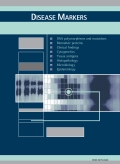Authors: Pedroni, M. | Roncari, B. | Maffei, S. | Losi, L. | Scarselli, A. | Di Gregorio, C. | Marino, M. | Roncucci, L. | Benatti, P. | Ponti, G. | Rossi, G. | Menigatti, M. | Viel, A. | Genuardi, M. | de Leon, M. Ponz
Article Type:
Research Article
Abstract:
Hereditary NonPolyposis Colorectal Cancer (Lynch syndrome) is an autosomal dominant disease caused by germline mutations in a class of genes deputed to maintain genomic integrity during cell replication, mutations result in a generalized genomic instability, particularly evident at microsatellite loci (Microsatellite Instability, MSI). MSI is present in 85–90% of colorectal cancers that occur in Lynch Syndrome. To standardize the molecular diagnosis of MSI, a panel of 5 microsatellite markers was proposed (known as
…the "Bethesda panel"). Aim of our study is to evaluate if MSI testing with two mononucleotide markers, such as BAT25 and BAT26, was sufficient to identify patients with hMLH1/hMSH2 germline mutations. We tested 105 tumours for MSI using both the Bethesda markers and the two mononucleotide markers BAT25 and BAT26. Moreover, immunohistochemical evaluation of MLH1 and MSH2 proteins was executed on the tumours with at least one unstable microsatellite, whereas germline hMLH1/hMSH2 mutations were searched for all cases showing two or more unstable microsatellites. The Bethesda panel detected more MSI(+) tumors than the mononucleotide panel (49.5% and 28.6%, respectively). However, the mononucleotide panel was more efficient to detect MSI(+) tumours with lack of expression of Mismatch Repair proteins (93% vs 54%). Germline mutations were detected in almost all patients whose tumours showed MSI and no expression of MLH1/MSH2 proteins. No germline mutations were found in patients with MSI(+) tumour defined only through dinucleotide markers. In conclusion, the proposed mononucleotide markers panel seems to have a higher predictive value to identify hMLH1 and hMSH2 mutation-positive patients with Lynch syndrome. Moreover, this panel showed increased specificity, thus improving the cost/effectiveness ratio of the biomolecular analyses.
Show more
Keywords: MSI, HNPCC, colorectal cancer, MLH1, MSH2
Citation: Disease Markers,
vol. 23, no. 3, pp. 179-187, 2007
Price: EUR 27.50





